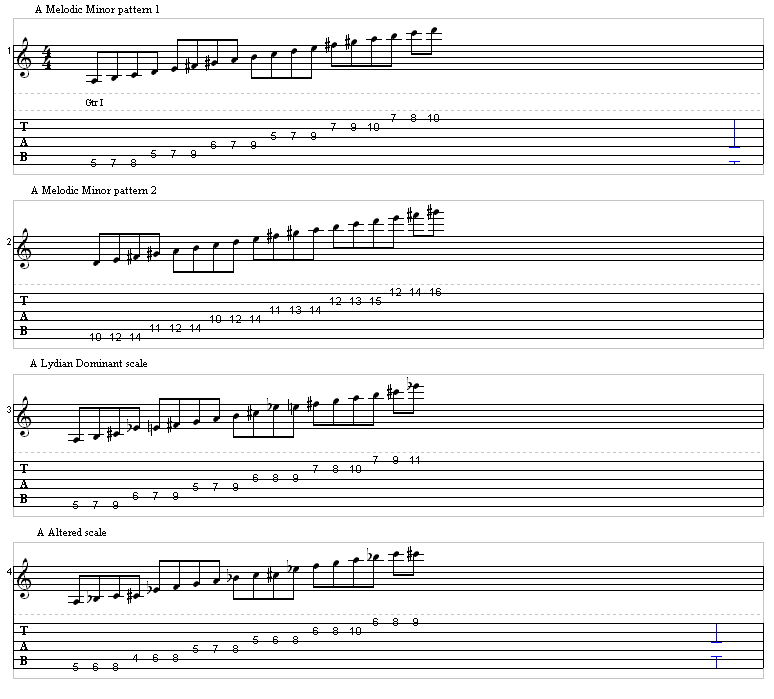If you are a rock or metal guitar player chances are when you hear the words melodic minor you think, "What, there's another kind of minor"? Yes, and it is actually very useful too. In this latest installment of Soloing Strategies we will explore the wonderful world of melodic minor.
So what exactly is this melodic minor thing? Simply put if you take a natural minor scale and raise the sixth and seventh degrees you will arrive at the melodic minor scale. Alternatively, you could take a major scale and lower the third degree. Either way you will arrive at the following scale pattern: (1, 2, b3, 4, 5, 6, 7). The uses of this scale are many and varied but to list a few here is what I would suggest. This can be used over a minor (major 7) chord. It is also used over simple minor chords or power chords, as well as over a minor seventh chord to take advantage of the tension added by the raised seventh of the scale. No it's not the prettiest thing ever but it does give a wonderfully cool, jazzy outside feel as long as you resolve the line on a consonant tone. Try using some wide interval lines and sequences to really jazz it up (pun intended, sorry).
Just as is the case with harmonic minor, the real story of melodic minor is in its modes. In fact I prefer some of melodic minor's modes to melodic minor itself. Let's get to them shall we?
Melodic Minor - (1, 2, b3, 4, 5, 6, 7)
Dorian b2 - (1, b2, b3, 4, 5, 6, b7)
Lydian #5 (Lydian Augmented) - (1, 2, 3, #4, #5, 6, 7)
Lydian b7 (Lydian Dominant) - (1, 2, 3, #4, 5, 6, b7)
Mixolydian b13 - (1, 2, 3, 4, 5, b6, b7)
Locrian #2 - (1, 2, b3, 4, b5, b6, b7)
Altered (Super Locrian) - (1, b2, #2, 3, b5, #5, b7)
Just like the diatonic modes these can be derived by starting at each step of the melodic minor scale. Starting on the second step of melodic minor will give you Dorian b2. Start on the fourth step and you have Lydian Dominant etc. Next we need to figure out what we can do with these guys so let's start with the first one that isn't melodic minor. Dorian b2 can be used to add color to simple minor and minor seventh chords. Try to steer clear of anything with a ninth as the tension created will be as pleasant as spending the weekend at your in-laws.
Lydian Augmented works exactly where the name implies, over augmented chords. Lydian Dominant works over dominant chords. What makes this scale so cool is that it is interchangeable with mixolydian. Think of it as a cooler mixolydian. Mixolydian b13 also works over dominant chords; however you will want to avoid anything with a sixth in it. Locrian #2 works over diminished and half diminished chords. I know it's pretty darn ugly. Altered is super useful because it works over altered dominant chords and if you dabble in jazz at all, you know there are altered chords aplenty in bop.
As I stated with harmonic minor, no scale is better than any other, they are just different tools for your improvisational tool kit. These are colors that give you creative freedom once you understand how they are applied and you can interface with the patterns all over the neck. I should point out that one thing you have to have a solid grip on to be a better soloist is harmony or chord theory if you prefer thinking of it that way. It will allow you to pick different scales that fit the chords on the fly and as a result give you way more options. If you are a metal player don't be put off by the jazz-centric explanation of how to use these, as they are awesome for rock and metal as well. Hey, it doesn't get much simpler than a root fifth power chord. Meaning you can use these scales just about anywhere. I am including some tab of suggested patterns to memorize in order to get these working.

Good luck!
Scott Allen is a 1996 graduate of the Musician's Institute, G.I.T. He currently teaches guitar to 65 to 70 students weekly at Northridge Music Center.
His latest CD is entitled "III", featuring his impressively fluid playing, with a style marked by an incendiary sense of phrasing.